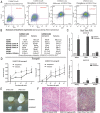Increased fucosylation has a pivotal role in invasive and metastatic properties of head and neck cancer stem cells
- PMID: 25428916
- PMCID: PMC4381579
- DOI: 10.18632/oncotarget.2698
Increased fucosylation has a pivotal role in invasive and metastatic properties of head and neck cancer stem cells
Abstract
Oral squamous cell carcinoma (OSCC) is an aggressive malignancy with high mortality rates. Major challenges for OSCC management include development of resistance to therapy and early formation of distant metastases. Cancer stem cells (CSCs) have emerged as important players in both pathologic mechanisms. Increased fucosylation activity and increased expression of fucosylated polysaccharides, such as Sialyl Lewis X (SLex), are associated with invasion and metastasis. However, the role of fucosylation in CSCs has not been elucidated yet. We used the spheroid culture technique to obtain a CSC-enriched population and compared orospheres with adherent cells. We found that orospheres expressed markers of CSCs and metastasis at higher levels, were more invasive and tumorigenic, and were more resistant to cisplatin/radiation than adherent counterparts. We found fucosyltransferases FUT3 and FUT6 highly up-regulated, increased SLex expression and increased adhesion by shear flow assays in orospheres. Inhibition of fucosylation negatively affected orospheres formation and invasion of oral CSCs. These results confirm that orospheres are enriched in CSCs and that fucosylation is of paramount importance for CSC invasion. In addition, SLex may play a key role in CSC metastasis. Thus, inhibition of fucosylation may be used to block CSCs and metastatic spread.
Conflict of interest statement
The authors indicate no potential conflicts of interest.
Figures




References
-
- Scully C, Bagan J. Oral squamous cell carcinoma overview. Oral oncology. 2009;45(4-5):301–308. - PubMed
-
- Warnakulasuriya S. Global epidemiology of oral and oropharyngeal cancer. Oral oncology. 2009;45(4-5):309–316. - PubMed
-
- Zhang P, Zhang Y, Mao L, Zhang Z, Chen W. Side population in oral squamous cell carcinoma possesses tumor stem cell phenotypes. Cancer letters. 2009;277(2):227–234. - PubMed
-
- Kelly C, Paleri V, Downs C, Shah R. Deterioration in quality of life and depressive symptoms during radiation therapy for head and neck cancer. Otolaryngology--head and neck surgery : official journal of American Academy of Otolaryngology-Head and Neck Surgery. 2007;136(1):108–111. - PubMed
-
- Rogers SN, Ahad SA, Murphy AP. A structured review and theme analysis of papers published on ‘quality of life’ in head and neck cancer: 2000-2005. Oral oncology. 2007;43(9):843–868. - PubMed
Publication types
MeSH terms
Substances
Grants and funding
LinkOut - more resources
Full Text Sources
Other Literature Sources
Medical

